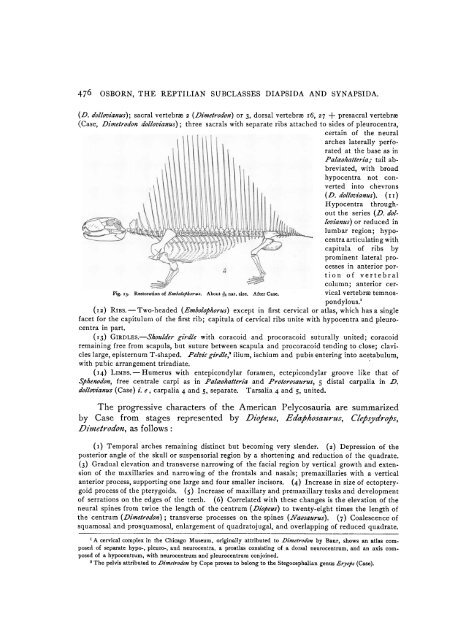American Museum of Natural History
American Museum of Natural History
American Museum of Natural History
You also want an ePaper? Increase the reach of your titles
YUMPU automatically turns print PDFs into web optimized ePapers that Google loves.
476 OSBORN, THE REPTILIAN SUBCLASSES DIAPSIDA AND SYNAPSIDA.<br />
(D. dollovianus); sacral vertebre 2 (Dirnetrodon) or 3, dorsal vertebrae i6, 27 + presacral vertebra<br />
(Case, Dimetrodon dollovianus); three sacrals with separate ribs attached to sides <strong>of</strong> pleurocentra,<br />
certain <strong>of</strong> the neural<br />
arches laterally perforated<br />
at the base as in<br />
Palaeohatteria;<br />
tail ab-<br />
breviated, with broad<br />
hypocentra not converted<br />
into chevrons<br />
Hypocentra through-<br />
~~out the series (D. dol-<br />
~~~~~~~~lumbaregion; hypo-<br />
centra articulating with<br />
capitula <strong>of</strong> ribs by<br />
prominen lateral pro-<br />
cesses in anterior por-<br />
~~~~tion <strong>of</strong> vertebral<br />
column; anterior cer-<br />
Fig. 13. Restoration <strong>of</strong> EmbotoAhorus. About IB nat. size. After Case. vical vertebrae temnospondylous.'<br />
(12) RIBS. Two-headed (Embolophorus) except in first cervical or atlas, which has a single<br />
facet for the capitulum <strong>of</strong> the first rib; capitula <strong>of</strong> cervical ribs unite with hypocentra and pleurocentra<br />
in part.<br />
(13) GIRDLES.-Shoulder girdle with coracoid and procoracoid suturally united; coracoid<br />
remaining free from scapula, but suture between scapula and procoracoid tending to close; clavicles<br />
large, episternum T-shaped. Pelvic girdle,2 ilium, ischium and pubis entering into acetabulum,<br />
with pubic arrangement triradiate.<br />
( 14) LIMBS.- Humerus with entepicondylar foramen, ectepicondylar groove like that <strong>of</strong><br />
Sphenodon, free centrale carpi as in Palceohatteria and Protorosaurus, 5 distal carpalia in D.<br />
dollovianus (Case) i. e, carpalia 4 and 5, separate. Tarsalia 4 and 5, united.<br />
The progressive characters <strong>of</strong> the <strong>American</strong> Pelycosauria are summarized<br />
by Case from stages represented by Diopeus, Edaphosaurus, Clepsydrops,<br />
Dimetrodon, as follows:<br />
(i) Temporal arches remaining distinct but becoming very slender. (2) Depression <strong>of</strong> the<br />
posterior angle <strong>of</strong> the skull or suspensorial region by a shortening and reduction <strong>of</strong> the quadrate.<br />
(3) Gradual elevation and transverse narrowing <strong>of</strong> the facial region by vertical growth and extension<br />
<strong>of</strong> the maxillaries and narrowing <strong>of</strong> the frontals and nasals; premaxillaries with a vertical<br />
anterior process, supporting one large and four smaller incisors. (4) Increase in size <strong>of</strong> ectopterygoid<br />
process <strong>of</strong> the pterygoids. (5) Increase <strong>of</strong> maxillary and premaxillary tusks and development<br />
<strong>of</strong> serrations on the edges <strong>of</strong> the teeth. (6) Correlated with these changes is the elevation <strong>of</strong> the<br />
neural spines from twice the length <strong>of</strong> the centrum (Diopeus) to twenty-eight times the length <strong>of</strong><br />
the centrum (Dimetrodon); transverse processes on the spines (Naosaurus). (7) Coalescence <strong>of</strong><br />
squamosal and prosquamosal, enlargement <strong>of</strong> quadratojugal, and overlapping <strong>of</strong> reduced quadrate.<br />
I A cervical complex in the Chicago <strong>Museum</strong>, originally attributed to Dimetrodon by Baur, shows an atlas composed<br />
<strong>of</strong> separate hypo-, pleuro-, and neurocentra, a proatlas consisting <strong>of</strong> a dorsal neurocentrum, and an axis composed<br />
<strong>of</strong> a hypocentrum, with neurocentrum and pleurocentrum conjoined.<br />
2 The pelvis attributed to Dimetrodon by Cope proves to belong to the Stegocephalian genus Eryops (Case).

















